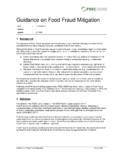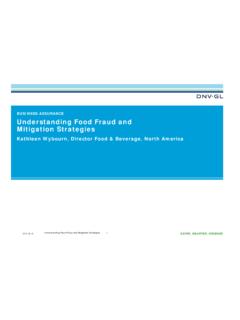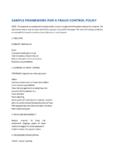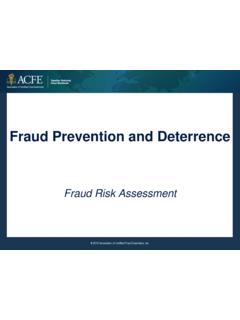Transcription of Facility Vulnerability Assessment Template
1 Department of the Interior bureau of reclamation May 2009 Facility Vulnerability Assessment Template Invasive Quagga and Zebra Mussels Department of the Interior bureau of reclamation May 2009 Facility Vulnerability Assessment Template Invasive Quagga and Zebra Mussels Prepared for reclamation by: RNT Consulting Inc. 823 County Road 35 Picton, Ontario, Canada K0K 2T0 1 Facility Vulnerability Evaluation Checklist Project Name: Prepared by: Date of Preparation: Issue #: Date of This Issue: A Facility Assessment process usually requires considerable time for planning and coordination, background research, site visits, evaluation of data and preparation of a report. Several small facilities that are similar or duplicates may be grouped together. It is likely that a team approach of 2 or 3 people is most effective at carrying out the Assessment with at least one of the team having operations knowledge/experience of the specific Facility (as explained below).
2 The Assessment team lead should become familiar with general mussel characteristics and behavior or possibly have a support person familiar with mussels as part of the Assessment team. The specific risks and problems that a particular Facility will have with the dreissenids will depend on: 1. How the raw water gets into the Facility , 2. Any processes to treat or transform the water for various Facility applications, 3. The routing of all piping branches and location of components and equipment, including materials of construction, and 4. The operating envelope of the various water systems (such as max and min flow rates, frequency of operation, temperature ranges). As every Facility has a number of unique features, a site person familiar with the operation of the various water uses in the plant/ Facility is an essential contributor to the Assessment . This Assessment Template can be used under most circumstances and for the most common assets to assist in carrying out a Facility Assessment .
3 If your asset is a small fish hatchery or a large pumping plant, knowing what must be protected either from primary settlement by mussel larvae or from ingress of adult mussel shells, is key. The Template is best applied after an environmental Assessment of the water source for susceptibility to mussel invasion is carried out. However, such an Assessment is not a prerequisite of applying this Template . Management may decide to proceed with a Facility Assessment ahead of or in parallel with the Assessment of environmental suitability. As a minimum, it is strongly recommended that the calcium content of the water passing through the Facility be checked to determine whether there is sufficient calcium to support mussels. As a guideline, calcium contents of 8 mg/L or less will not support long term survival of adult mussels. There are of course other parameters which may mitigate or preclude mussels thriving in your waters but all become irrelevant if sufficient calcium to support mussel survival is not present.
4 2 Water in contact with concrete and mortar can cause a steady deterioration of these materials by leaching out the calcium from the calcium silicate bonding materials. This action is most pronounced with soft or mildly acidic waters such as are found in reservoirs fed from swampy areas. Where there are concrete structures that are relatively sheltered, a local area of elevated calcium may exist that would support mussels. In reservoirs of low or marginal calcium, such sheltered areas would be good locations to monitor for mussels especially if the concrete structures show any form of deterioration due to concrete leaching. 1. Instructions for Using this Document For each Item No. below, complete all blank fields (see footnotes for Status and Comments columns). The checklist is divided into logical phases. It is best not to proceed from one phase to the following phase until that phase is completed. Within each phase, many tasks will likely proceed in parallel and the order in which they are done is at the team leader s discretion.
5 Issue this checklist with your weekly or monthly reports as appropriate. Be sure to identify the issue date so readers know they are looking at the most recent update and are able to assess progress or provide input to the program. This Template is set up for a small size project. Appendix A contains an outline for a minor project Project Plan. This is provided for the guidance of the user and not intended to replace standard project methodologies that may exist within the bureau . Appendix A also contains some helpful suggestions concerning the project team skills and roles. Also included in appendix A is a sample time/task chart (Gantt chart). The durations are intended to be representative of a real Facility Assessment but you should adjust these for your own circumstances. It may be helpful to place dates in the appropriate checklist item if it is considered unnecessary to use the Gantt chart approach. Instructions, comments or suggestions in this main document are provided in boxes with a yellow background.
6 3 2. Preparation (Step 1) Item No. Item Status 1 Comments / Plan to Resolve 1 Planning Has the project scope including definition and objectives been prepared? Has the Project Scope Statement been approved? Is there a Project Plan against which to measure progress? Does the Project Plan address the following areas: Project Scope and Deliverables Project Schedule Project Budget Project Organization and Resources Were key project stakeholders brought into the Project Plan? Were potential customers involved early in the planning process? If there are vendors, have they signed off on the Project Plan? If there is an independent oversight contractor, have they signed off on the Project Plan? Is the Project Sponsor function identified and defined? Are there alternate persons if key members of the project are not available or become reassigned?
7 Other organization items (please list): 2 Tracking & Monitoring Are the various types of reports, their contents, frequency, and audience defined and communicated to the Project Team? Are the input requirements from Project Team members clearly documented and communicated? 3 Meetings and Input Data Have the various meetings, purpose, context, frequency, and participants been defined and communicated? Have the drawings and documents from the Facility sites been requested? 4 Project Assumptions and Constraints Are there any key assumptions upon which the Assessment is based and have these assumptions been documented? Does the Project have any Constraints such as: Facility shutdown schedules? Facility access limitations and ventilation requirements? Monitoring issues such as availability of reports from sampling plates set out in previous seasons? 1 Enter one of the following: C (Complete), P (Partially Complete), Y (Yes), N (No); NA (Not Applicable) 4 2.
8 Preparation (Step 1) Item No. Item Status 1 Comments / Plan to Resolve Any training needed for key project staff? Any pre-project procurement needed for portable field equipment? 3. In-house Review and Preparation for Field Visits (Step 2) Item No. Item Status 2 Comments / Plan to Resolve 1 Reviewing Have drawings and documents from the Facility site been reviewed? Have questions arising from the document review been communicated to and discussed with the site experts? Did the document review identify any pre-site-visit activities that should be done such as video inspections requiring divers or shutdown of equipment that needs to be scheduled? Are all pre-site-visit tasks needed to be done at site completed? Has the deliverables list been updated based on the information from the site documents? Have all system checklist sheets been prepared? 2 Enter one of the following: C (Complete), P (Partially Complete), Y (Yes), N (No); NA (Not Applicable) 5 4.
9 Site Visits, Follow-up and Reporting (Step 3) The general approach should be to follow the path of the water through the site Facility . The water path will become more complicated each time the water branches into a specific system. Follow each system in turn and you will have covered the complete flow of water through the Facility . Item No. Item Status Comments / Plan to Resolve 1 Field Walkthroughs Has the pre-meeting at site been completed? Were all necessary site staff available? Have follow-up discussions with staff not available during the site visit been scheduled and completed? Have all the system walkthrough checklists been completed? Have all actions arising from the site meeting and system walkthroughs been documented and communicated to the person responsible for the action? Has the draft project report been reviewed by all contributors? Has the final report been approved for issue? Has the final report been distributed? 5.
10 Mussel Risk Evaluation - Project Team Contact List Project Name: Project Lead: Some suggestions for the roles of the various team members and the skills or knowledge that would be helpful for each team member are contained in Appendix A. Name Title Location Office Phone & E-mail 6 6. Mussel Risk Evaluation Sample Facility Deliverables List Facility Name: The deliverables are internal document packages prepared for each system or major structure. Once all deliverables are completed, they are then used to prepare the overall Assessment report which would be the only external deliverable. It will be helpful when preparing this list to refer to Appendix D for additional detail about typical systems and components at risk that should be considered. Major Structure or System Reference drawings Used Deliverables 1: Dam List all General Arrangement (GA s), plan view and cross sections as well as any detail drawings Copies of all drawings + photographs + dam walkthrough checklist.



















